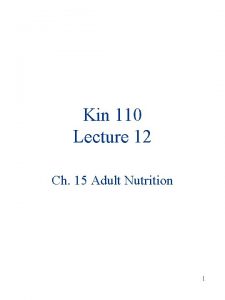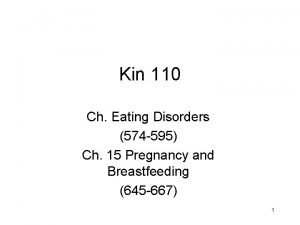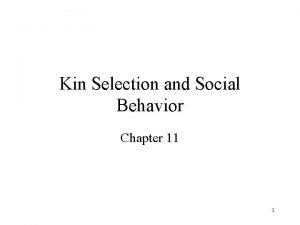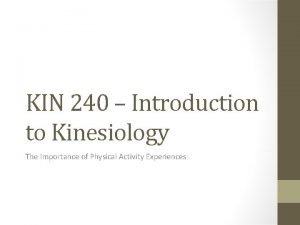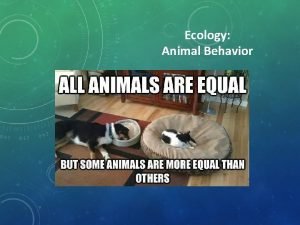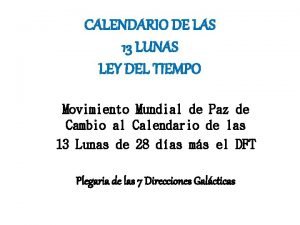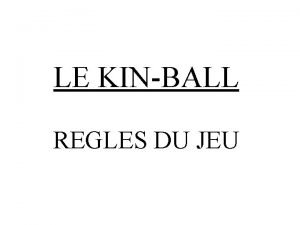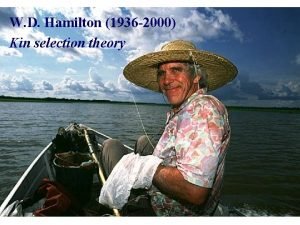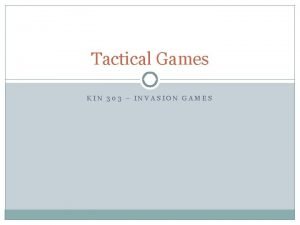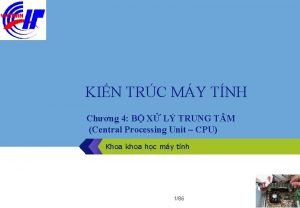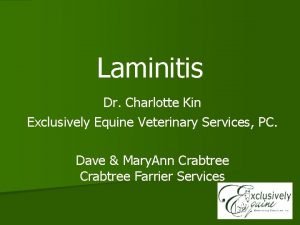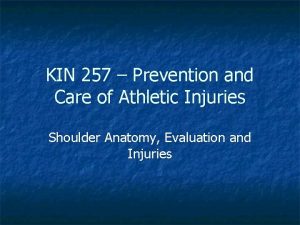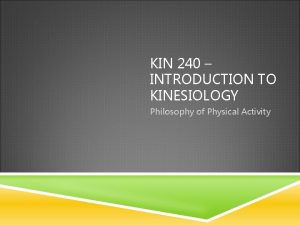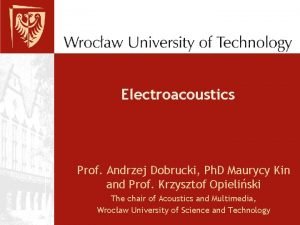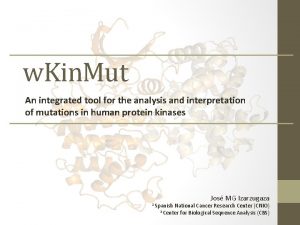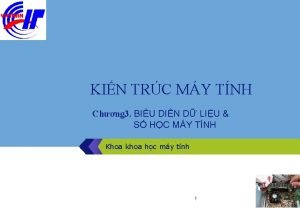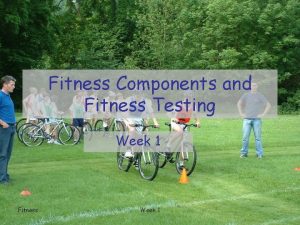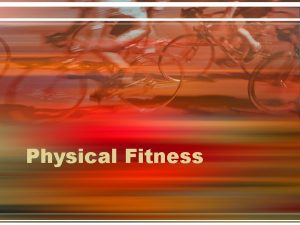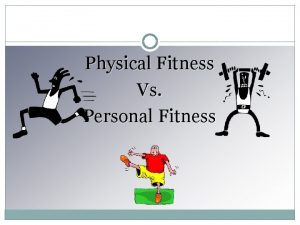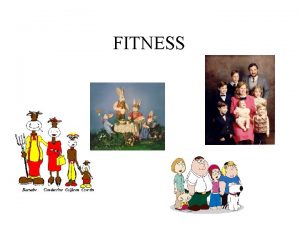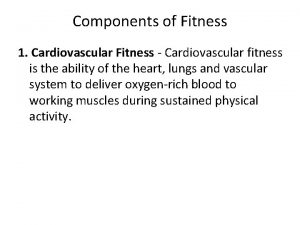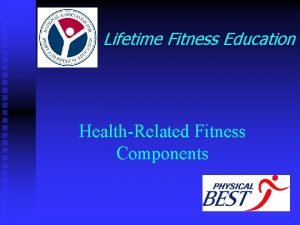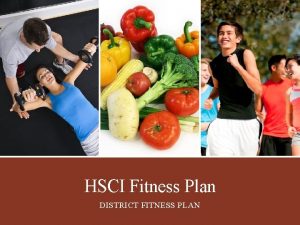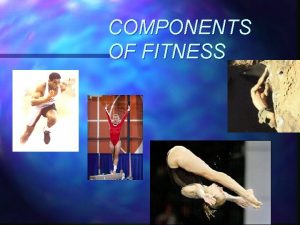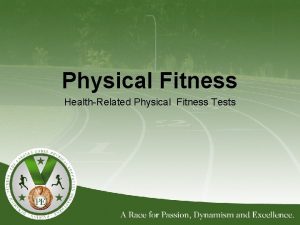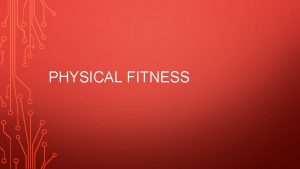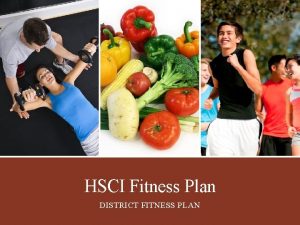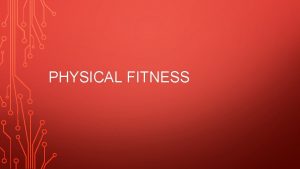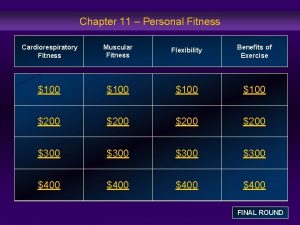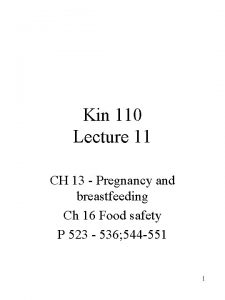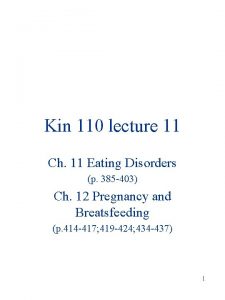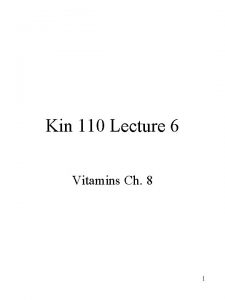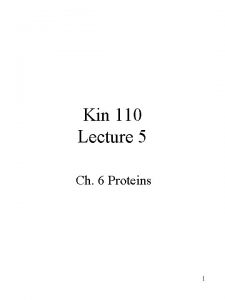Kin 110 Lecture 10 Ch 11 Fitness and

























- Slides: 25

Kin 110 Lecture 10 Ch. 11 Fitness and Sport 1

Fitness and Sport • Activity and Nutrition are necessary together – good nutrition is essential for performance and – activity is essential for weight control and a healthy body composition • adequate fluid and carbohydrate intake are needed to perform • Physical Fitness - ability to do moderate to vigorous activity without undue fatigue • The type of Fuel used to sustain physical activity is affected by – Fitness level – intensity of activity – diet 2

Benefits of Exercise • Only about 15% of adults practice moderate to vigorous physical activity on a regular basis • Fig 11 -1 - Benefits • Improve overall Fitness • Skill - agility, balance, coordination, reaction time • Health - endurance, body composition, muscular and skeletal fitness • Reduced risk for heart disease – heart muscle and circulation – reduce other risk factors – BP, TG, lipoproteins 3

Benefits of Exercise • Prevents and treats obesity – caloric use – stimulates fat burning and mobilization – Maintain lean body mass • Prevents and controls diabetes – Increases glucose uptake in absence of insulin – Contributes to weight balance • Osteoporosis • Reduce infections • Enhances psychological health 4

Designing a Program • Kinesiology 143 • (PAR-Q) – over 35 speak with a physician before drastically increasing activity • Phase 1 • incorporate 30 minutes of moderate activity into your daily routine – Walk, take stairs, house cleaning, gardening – Effects are cumulative - so they can be broken up into 10 min sections • develop habits and use of body 5

Basic Fitness Program • Phase Two • increase goal to 30 min of more vigorous activity 3 -5 days per week – Fig 11 -2 • include resistance exercise – 2 -3 times per week • Warm-up – slow jog, flexibility (2 -3 per week) • workout – 65 -85 % of Heart Rate Max • heart rate max = 220 - age • cool down – slow jog, flexibility 6

FITTE Formula • Frequency, Intensity, Time, Type and Enjoyment • F - 3 -5 times per week • I - 65 -85% max HR – 4 -6 range on RPE scale p 380 • T - 20 -40 minutes • T - any aerobic activity, repetitive use of large muscle groups – Running, swimming, cycling, circuit training • E - make sure you pick activities that you enjoy • Progression - important to start slowly but also challenge your body to continue to adapt by increasing one component (FIT) at a time 7

Metabolism • All chemical reactions that occur in the body – release of energy from foods – conversion of substances – preparation of excretions • Metabolic pathway – sequence of chemical reactions • Anabolic - building • Catabolic - breakdown – digestion – energy release from carbohydrates and lipids forming CO 2 + H 2 O 8

Energy Sources for Muscle • Table 11. 1 - energy sources • Adenosine Tri-phosphate (ATP) – energy currency for cells – Fig p 381 • ion pumping, enzyme activity, muscle contraction • Solar energy from Sun trapped by plants and stored as chemical energy • ADP + Pi + energy => ATP – ATP stores can sustain muscle for 2 -4 seconds 9

Maintaining ATP • Breakdown of Phospho. Creatine, Carbohydrates, Fats, and Protein maintain ATP • ATP breakdown products activate the splitting of PCr – Phosphocreatine • sustains ATP for about 10 seconds of maximal activity • fastest most powerful activities use this system to replace a majority of ATP 10

Carbohydrates • Blood glucose and Muscle Glycogen • Glycolysis – catabolism of glucose for ATP • First Phase - very rapid – low yield ( 2 ATP / glucose) – Supports activities lasting that can be maximal for 30 sec. to 2 min. • Low O 2 - Anaerobic Glycolysis – intense exercise - Lactic Acid – Acid buildup can inhibit activity 11

Carbohydrate • High O 2 - Aerobic Glycolysis – moderate to low intensity exercise – Oxygen demand can be maintained and can support ATP requirements • breakdown products move to mitochondria – completely broken down into CO 2 and H 2 O • requires O 2 – yields 36 ATP/glucose – more efficient but slower than anaerobic – Predominates for sustained activity lasting 2 min to 4 or 5 hours 12

Carbohydrate Sources • Blood Glucose and Glycogen – Main source is muscle glycogen • Glycogen depletion – exercise capacity is cut in half • Carbohydrate loading – Prevents severe depletion and “hitting the wall” • contribution of blood glucose is very important after 20 -30 min – – carbohydrate intake during exercise 30 -60 g per hour maintain blood glucose delay fatigue 30 - 60 minutes 13

Fats : low intensity fuel • Slow metabolism, important for bouts longer than 20 minutes • massive storage – Adipose – Muscle • caffeine increases availability and utilization • “hitting the wall” - can only sustain a fast walk or slow jog – * because only fuel source is fats* – Carbohydrates have run out • Fig 11 -3 - ATP formation • Fig 11 -4 - fuel use • “ Fat burning Zone? ? ” 14

VO 2 max. = 2. 0 liters/min Conclusion: more fat (and total calories) is/are burned at a higher intensity for exercise over the same duration(time).

Power Foods Dietary Guidelines • Proper diet will maximize an athletes potential • Athletes need to add the energy required for training to the basal requirements – Estimate 5 -8 kcal/min (for moderate activity) • Assessment of body composition is important – body fat %, weight change – Fluid and electrolyte replacement 16

High Carbohydrates • Higher intake for athletes • To replenish glycogen stores • increase carb intake from 5 g/day/Kg to 7 g/day/Kg • focus on carbohydrate rich sources, to supplement needs • 60 - 70 % of kcal from carbohydrates • Fig. 11 -4 – potatoes, brown rice, whole grain pasta 17

Carbohydrate loading • Appropriate for continuous events lasting over 90 min – Marathon, triathlon, basketball tournament, X-country skiing • shorter events repeated within 24 hours - time trials, heats/finals • Table 11. 2 - daily menu • couple with tapering of training (reduction) before competition • caution, can increase water retention with glycogen storage • *Eat Carbo rich foods after exercise Juice, yogurt…* • Recommendations for carbohydrate loading prior to competion - p 389 18

Protein • Small contribution to energy • endurance 10 -15 %, especially with inadequate Carbohydrates • ? Anabolic effect of carbohydrate rich diet? – Insulin, growth hormone • protein generally met by balanced diet • may need increase for high level endurance and weight training athletes – increase to 1. 0 -1. 6 g/Kg body weight • From. 8 g/kg for general population – AA or protein supplements are not necessary 19

Vitamins and Minerals • Same or slightly higher requirements than sedentary • May be some antioxidant protection with higher vitamin C and E • balanced diet should be fine • Iron - deficiency anemia impairs performance • Calcium – osteoporosis, stress fracture risk due to decreased bone density in female athletes no longer menstrating regularly 20

Body Fluids • 6 -8 cups per day • Sweat losses, 3 -8 cups per hour • body temperature increases with loss of 3% body weight in H 2 O – reduced endurance, strength and performance • Heat Illness – profuse sweating, headache, dizziness, nausea, vomiting – maintain fluid intake, avoid intense exercise in extremely hot and humid environments 21

Fluid intake • Drink regularly up to 2 hours before activity ( water, diluted fruit juice, sports drink) • 20 - 30 min before 1 -1. 5 cups • during. 5 to 1 cup every 20 min • 6 -8 % glucose (sports drinks) – otherwise impairs absorption • After, 2 cups per pound lost – One Litre per Kg • Sports drinks? – Carbohydrate and electrolyte replacement in addition to water may be important for events lasting longer than 60 minutes in hot weather 22

Pre Game Meal • Light - 300 -100 kcal – 2 -4 hours before event • primarily carbohydrates (70%) – milk, grapefruit, baked beans, apples – sustained release of glucose • low insoluble fiber • blend food for easy digestion if only 1 -2 hours before event – cliff bar, power bar • ? avoid carbohydrates one hour before event - athlete specific • Table 11. 5 pre event meals 23

After Exercise • Table 11. 7 post event meals • Carbohydrate rich foods within 2 hours - 50 -200 g – fruit juice, candy, sports drinks • electrolyte replacement – Na+, K+ - (salt, banana) • sports drinks most important for 60 - 90 minute events – large loss of sweat (and electolytes) • glucose polymer (linked glucose) - OK – fructose absorbed slowly 24

Learning Objectives • Design a basic fitness program • Describe when and how glycogen, blood glucose, fat and protein are used to meet energy needs during different types of activity • Differentiate between anaerobic and aerobic use of glucose - including advantages and disadvantages • Show muscles adapt to an increase in physical activity • Outline how to estimate an athletes energy needs and the nutrient requirements of a training diet (carbs) • Examine problems with rapid weight loss and dehydration • Describe effects of various ergogenic aids on an athletes performance 25
 Kin 110
Kin 110 Kin 110
Kin 110 Où se trouve le numéro d'affiliation mutuelle vignette ?
Où se trouve le numéro d'affiliation mutuelle vignette ? 011 101 110
011 101 110 Health-related
Health-related 01:640:244 lecture notes - lecture 15: plat, idah, farad
01:640:244 lecture notes - lecture 15: plat, idah, farad Kin i
Kin i Hamilton's rule equation
Hamilton's rule equation Kin 240
Kin 240 Kin selection
Kin selection 13 lunas kin maya
13 lunas kin maya Kin ball cycle 2
Kin ball cycle 2 Kin 464
Kin 464 Chấn thương ngực kín slide
Chấn thương ngực kín slide William hamilton kin selection
William hamilton kin selection Kin 303
Kin 303 Kin tes
Kin tes Logo kin
Logo kin Exclusively equine vet
Exclusively equine vet Kin 257
Kin 257 Kin 240
Kin 240 Kin policing
Kin policing Dr kin tsui
Dr kin tsui Pinna acoustics
Pinna acoustics Svm kernel
Svm kernel Chuyển số thực sang ieee 754
Chuyển số thực sang ieee 754
